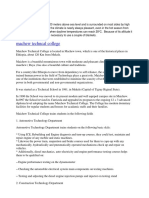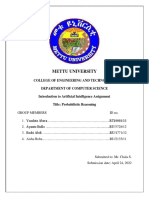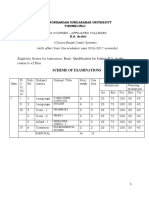Admas University
School of Postgraduate Studies
Course Outline
Course Title: Quantitative Methods for Decision Making
Course Code: MBA 582
Credit Hours: 3hrs
COURSE DESCRIPTION
Quantitative analysis for decision making belongs to management science as one of the quantitative aids to
managerial decision making. It offers the decision-maker a method of evaluating every possible alternative
(act or course of action) by using various techniques to know the potential outcomes. The course is,
therefore, designed to provide an understanding of history and latest development of Management Science
tools and models. Students will be exposed to the process of system approach to design and development
of quantitative models. The course will also focus on the use of tools and the development of models from
case studies. It includes Models and modeling, linear programming, transportation models, assignment
models, decision models, project management techniques, game theory and queuing models.
Course Objectives
Upon successful completion of this course, students should be able to:
a) Use concepts and methods of Decision Science, which involves the application of mathematical
modeling and analysis to management problems.
b) Apply a foundation in modeling with spreadsheets.
c) Build and use models and model-based analyses.
d) Identify and apply a more disciplined thinking process in the way they approach management
situations.
e) Appreciate the application of OR model in solving different quantitative problem.
1
�Course Contents
Chapter One: Introduction
1.1 Introduction to concepts of Quantitative Analysis for Decision Making
1.2 Development in management theory and practice (from scientific management to management
science)
1.3 Review of probability Theory; Bayesian statistics in particular (for independent review)
1.4 Decision making through quantitative analysis: management science models.
1.5. Model and modeling in Operations Research
Chapter 2 - Linear Programming
2.1. Introduction
2.2. Structure of Linear Programming Model
2.3. Application Area of LP
2.4. Graphical Solutions of LPP
2.5. Special Case in LPP
2.6. The Simplex Method
2.7. Some complication and their Resolution
2.7.1. Unrestricted variables
2.7.2. Tie for leaving and entering variables
2.8. Duality in LPP
2.9. Sensitivity Analysis
Chapter 3 - Transportation and Assignment Problems
3.1. Introduction
2
� 3.2. Methods for Finding Initial Solution
3.3. Test for Optimality
3.4. Variation in Transportation
3.4.1. Unbalanced supply and demand
3.4.2. Degeneracy
3.4.3. Alternate optimal solution
3.4.4. Prohibited transportation routes
3.5. Maximization in Transportation problems
3.6. Solution method for Assignment problem
3.7. Special case in Assignment Problems
Chapter Four: Queuing (waiting line) Analysis
4.1 Elements of waiting line analysis
4.2 The single server waiting line system
4.3 Undefined and constant server times
4.4 Finite queue length
4.5 Finite calling population
4.6 The multiple server waiting line
Chapter Five: Decision Theory
5.1. Introduction
5.2. Types of Decision Making Environment
5.3. Decision making under Uncertainty
5.4. Decision making Under Risk
5.5. Decision making Under Certainty
5.6. Decision Making with Utilities
3
� 5.7. Monte Carlo Simulation
5.8. Stochastic Dominance
5.9. The value of Information
Chapter Six: Network Analysis
6.1. Introduction
6.2. Types of Network Models
6.2.1. The Shortest Route Problem
6.2.2. The Maximal Flow Problem
6.2.3. Critical Path Method (CPM) and PERT
6.3. Time – cost Trade Offs – Crashing
Teaching Methods
The principles of active learning approach will be implemented in this class. Class participation is vital to
learning and demonstrating proficiency in Management Science for Decision Making. For the graduate
student, participation means initiating questions, engaging in peers discussions and drawing from life and
work experience to enrich class discussion. Students are, therefore, expected to read, think about the issues
and prepare to contribute to class discussion by sharing their experiences.
The course instructor’s primary role is to facilitate the learning process. In each session, the instructor will
devote some time in lecturing, but we will also spend a great deal of time in class discussion. Moreover,
case studies and reflection exercises will also be employed.
Assessment Methods
• Problem solving questions (individual assignment)………. 25%
• Project work and presentation (groups)……………………. 35%
• Final examination…………………………………….………. 40%
4
�READING MATERIALS
Anderson, Sweeney, Williams, Camm and Martin (2012): An Introduction to Management
Science, Quantitative approach to decision making, Revised 13th Edition. (South-Western
Cengage Learning)
Hamdy A. Taha (2007),Operations Research: An Introduction. 8thEditionNew Delhi, Pearson
Education, Inc.
Hiller &Libermann (2001), Introduction to Operations Research, 7th Edition (McGraw Hill)
Bernard W.Taylor (2016) Introduction to Management Science. Boston: pearson
Prem, Kumar& D.S. Hira (1979) Operations Research. New Delhi: S. Chand & Company LTD.
ShermaJ.K.. (2003),Operations Research: Theory and Application. New Delhi: Macmillan
LTD.
Shaum’s Outline (1997).Theory and Problems of Operations Research. New Delhi: McGraw-
Hill Companies. Inc.
Srivastava, Shenoy and Sharma (1989), Quantitative Techniques for Managerial
Decisions,Inc2nd Ed. New Delhi McGraw-Hill Companies.

























































































